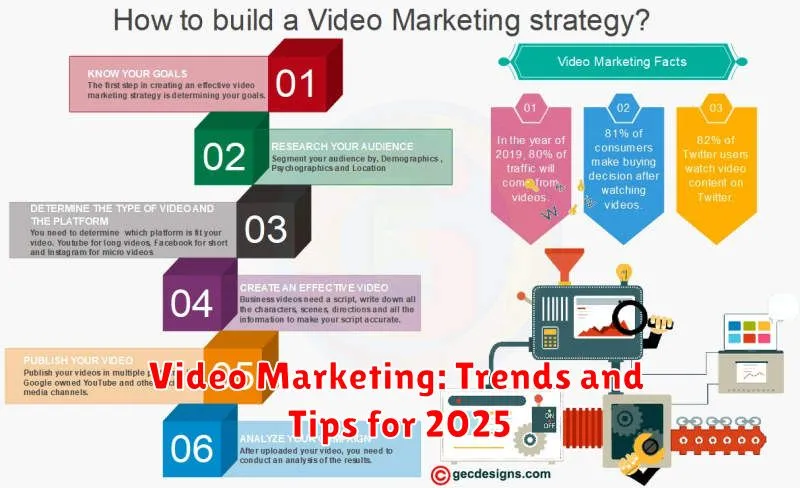Video marketing continues to dominate the digital landscape, and understanding the emerging trends and implementing effective tips is crucial for success in 2025. Staying ahead of the curve requires businesses to adapt their video marketing strategies to capture the attention of their target audience. This article will delve into the predicted video marketing trends shaping the future of online engagement and provide actionable tips to optimize your video content for maximum impact in the ever-evolving digital realm. From leveraging the power of short-form videos to incorporating interactive elements, we will explore the key strategies to elevate your video marketing efforts in 2025.
As we move closer to 2025, the video marketing landscape is becoming increasingly competitive. Therefore, it’s essential to not only understand the current trends but also anticipate future shifts. This article provides valuable insights into the projected video marketing trends for 2025 and offers practical tips for creating compelling video content. Whether you are a seasoned video marketer or just starting, this guide will equip you with the knowledge and strategies needed to succeed in the dynamic world of video marketing in 2025 and beyond. We will cover topics including the rise of AI in video creation, the importance of personalized video experiences, and the continued dominance of mobile-first video content.
Why Video Is Still King
In the ever-evolving digital landscape, video remains a dominant force. Its power lies in its ability to engage audiences on a deeper level than text or static images. Video’s dynamic nature captures attention and fosters stronger emotional connections, leading to improved brand recall and higher conversion rates.
Engagement is key in today’s fragmented media landscape. Video provides a more immersive and interactive experience, keeping viewers hooked and encouraging active participation. This active engagement translates into increased brand awareness and a stronger sense of community around a product or service.
The versatility of video content caters to a wide range of consumption habits. From short-form, easily digestible clips on social media to longer, in-depth tutorials and product demonstrations, video offers a format for every need. This adaptability makes it an invaluable tool for reaching target audiences across various platforms.
Looking ahead to 2025, video’s reign is expected to continue. As technology advances and internet speeds increase, the consumption of video content will only proliferate. Businesses that fail to incorporate video into their marketing strategies risk falling behind the curve.
Short-Form vs Long-Form Videos
When planning your video marketing strategy, a key consideration is video length. Broadly speaking, videos fall into two categories: short-form and long-form. Choosing the right format is crucial for maximizing impact.
Short-form videos, typically under 60 seconds, are ideal for capturing attention on platforms like TikTok and Instagram Reels. They thrive on visually engaging content and quick cuts, aiming to entertain and leave viewers wanting more. This format excels at building brand awareness and reaching a wide audience.
Long-form videos, exceeding a few minutes, allow for in-depth exploration of topics and fostering stronger connections with viewers. Platforms like YouTube are well-suited for this format. Long-form content provides opportunities for educational content, product demonstrations, and storytelling, ultimately driving deeper engagement and fostering brand loyalty.
The optimal choice between short-form and long-form depends on your specific marketing objectives and target audience. A balanced approach leveraging both formats is often the most effective strategy.
Video Platforms to Focus On

In 2025, businesses should prioritize video platforms that align with their target audience and marketing objectives. YouTube remains a cornerstone for long-form content and building a dedicated subscriber base. Leveraging its robust search and discovery features is crucial for organic reach.
Short-form video platforms like TikTok and Instagram Reels continue to dominate, demanding engaging and easily digestible content. These platforms excel at driving viral trends and reaching younger demographics. Facebook and Twitter, although established platforms, maintain relevance for video marketing, particularly for community building and reaching niche audiences.
Emerging platforms and interactive video experiences should be considered for experimentation. Live streaming across platforms like Twitch and YouTube Live offers opportunities for real-time engagement. Prioritizing the user experience and tailoring content to each platform’s specific format is essential for successful video marketing in 2025.
Creating Videos on a Budget
Creating engaging video content doesn’t require a Hollywood-sized budget. With a little creativity and resourcefulness, businesses can produce high-quality videos cost-effectively. One of the most important aspects is planning. Clearly define your video’s purpose and target audience before you begin.
Leverage readily available resources. Your smartphone’s camera is a powerful tool, especially when paired with affordable or free video editing software. Natural lighting can often replace expensive studio lighting. Simple backdrops, like a clean wall or a neatly organized bookshelf, work well. Focus on strong storytelling rather than flashy effects.
Repurpose existing content. Turn blog posts, presentations, or even social media updates into short video explainers. This is a cost-effective way to maximize your content’s reach. User-generated content can also be a valuable asset. Encourage your audience to share their experiences with your brand and incorporate that footage into your video marketing strategy.
SEO Optimization for Video Content
Optimizing your videos for search engines is crucial for maximizing visibility and reach. Keywords play a vital role. Conduct thorough keyword research to identify relevant terms your target audience is searching for.
Video titles should be concise, engaging, and incorporate your primary keyword. Descriptions offer a more detailed explanation of your video content. Use this space strategically to provide context and include relevant keywords.
Tags help categorize your video and improve searchability. Use a mix of broad and specific tags related to your video’s topic. A video transcript not only improves accessibility but also provides search engines with more textual content to index.
Thumbnails are the first impression viewers have of your video. Create visually appealing thumbnails that accurately reflect your content and encourage clicks. Consider using a custom thumbnail rather than a randomly generated one.
Promote your video across different platforms to increase engagement. Higher view counts, likes, and comments signal to search engines that your video is valuable, ultimately boosting its ranking.
Live Streaming Tips
Live streaming continues to be a powerful tool for engaging audiences in 2025. To maximize its effectiveness, focus on creating authentic and interactive experiences.
Preparation is key. Outline your stream’s content and have a clear purpose. Test your equipment beforehand to ensure a smooth, professional broadcast. Promote your live stream across your social media channels to build anticipation.
During the stream, actively engage with viewers by responding to comments and questions. Encourage real-time participation through polls and Q&A sessions. This fosters a sense of community and boosts engagement.
Consider using high-quality equipment, including a good camera, microphone, and lighting, to enhance the viewing experience. A stable internet connection is also crucial for a seamless broadcast.
Finally, don’t forget to repurpose your live stream content. You can edit it into shorter clips for social media or create a blog post summarizing the key takeaways. This extends the life of your content and reaches a wider audience.
Repurposing Video Across Channels
Maximizing the reach of your video content involves strategic repurposing across various platforms. A single high-quality video can be transformed to suit different channels, extending its lifespan and impact.
Consider extracting short, engaging clips from longer videos for platforms like TikTok and Instagram Reels. These bite-sized pieces of content capture attention quickly and cater to shorter attention spans. Add text overlays or captions to enhance accessibility and engagement.
Transform webinars and presentations into shorter, topic-focused videos for YouTube or educational platforms. This provides valuable content in a more digestible format, attracting a wider audience.
Podcast snippets can also be extracted from video interviews or discussions, offering a different way to consume information. Audiograms, featuring static images with audio waveforms, can promote these clips on social media.
A well-planned repurposing strategy ensures your video content reaches the widest possible audience and maximizes your return on investment.
Interactive Video Formats
Interactive video is transforming passive viewership into active participation. This trend is expected to grow significantly in 2025, offering viewers greater control and engagement. Shoppable videos enable direct purchases within the video itself, streamlining the path to purchase and boosting conversion rates.
360-degree videos immerse viewers in an environment, allowing them to explore and control their viewing perspective, which is particularly effective for travel, real estate, and product demonstrations. Gamified videos incorporate interactive elements like quizzes, polls, and challenges, driving deeper engagement and knowledge retention.
Branched narratives allow viewers to make choices that influence the storyline, creating personalized experiences and fostering a stronger connection with the content. Data collection through these interactions provides valuable insights into audience preferences and behaviors, informing future content strategies.
User-Generated Video Content
User-generated video (UGV) content continues to be a powerful tool in video marketing. Its authenticity resonates with audiences, fostering trust and building stronger connections with brands. Consumers are more likely to believe the experiences of their peers than polished corporate messaging. This makes UGV a valuable asset for building social proof and driving conversions.
In 2025, encouraging and leveraging UGV will be essential. Brands can actively solicit UGV through contests, challenges, and interactive campaigns. Re-sharing customer videos on official brand channels amplifies reach and demonstrates appreciation for customer engagement. Furthermore, partnering with relevant influencers or micro-influencers can facilitate the creation of high-quality UGV that aligns with brand messaging.
Remember to always obtain proper permissions before using any user-generated content. Clearly outline usage rights and compensate creators fairly when appropriate. Respecting intellectual property builds trust and encourages further participation in UGV initiatives.
Tools for Editing and Publishing
Utilizing the right tools is crucial for producing high-quality video content. Video editing software allows for precise cuts, transitions, and the addition of visual effects. Popular choices in 2025 include professional-grade applications and increasingly powerful, user-friendly mobile apps. Selecting the right tool depends on budget, technical skills, and desired outcome.
Beyond editing, publishing tools are essential for reaching your target audience. Platforms like video hosting sites offer various analytics and audience engagement features. Direct uploads to social media channels are also key, with each platform offering specific optimization tools. Choosing the right publishing platform depends on your marketing strategy and target demographic.
Key features to consider in both editing and publishing tools include support for various video formats, ease of use, and collaboration features. Advanced capabilities like AI-powered editing and automated publishing workflows are becoming increasingly prevalent, streamlining the video creation process.

